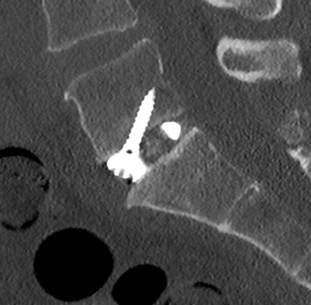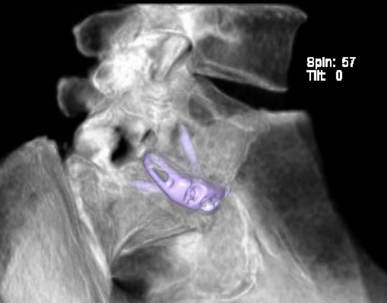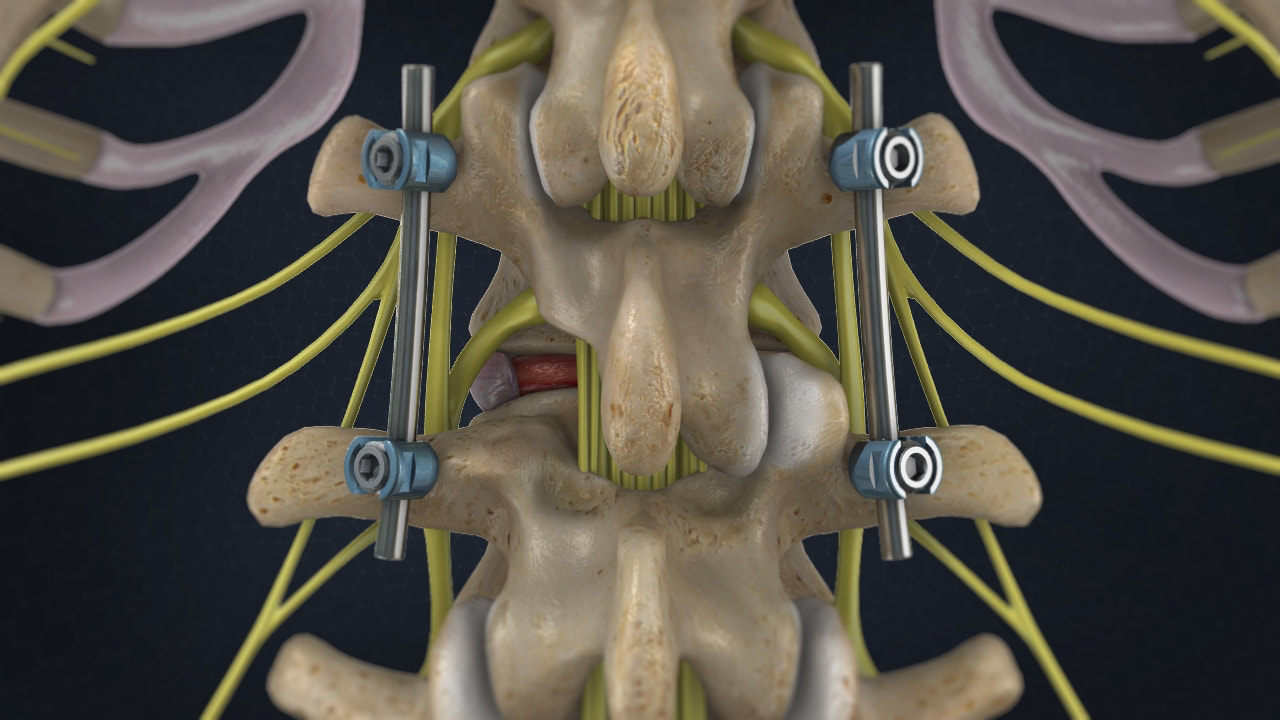Anterior Lumbar Interbody Fusion (ALIF) Information
Anterior Lumbar Interbody Fusion (ALIF) is a procedure used to fuse the lumbar spine, via an approach from the front of the spine through the abdomen. ALIF stands for:
Anterior - approach to the spine is from the front, through a small incision in the lower part of the abdomen
Lumbar - one or more vertebrae of the lumbar spine is fused
Interbody - fusion between two vertebral bodies where the disc usually would sit
Fusion - formation of bony bridge and stabilisation of the spine
Images showing ALIF anterior interbody fusion. The intervertebral disc has been removed. A single interbody spacer (cage) and bone graft is placed in the disc space to promote fusion and restore spinal alignment. Screws inserted into the bone (vertebral body) keep the implant in place.
ALIF is usually performed to treat conditions such as spondylolisthesis, scoliosis, recurrent disc prolapse, severe lumbar canal or foraminal stenosis, spinal instability, and severe disc degeneration (wear and tear). It is usually performed to relieve symptoms such as sciatica (leg pain), pins and needles, numbness or weakness in the legs or feet, and back pain.
|
Unlike traditional back surgery, ALIF is performed with the patient positioned on their back. The first part of the ALIF procedure is performed by a vascular surgeon. The vascular surgeon exposes the front of the spine through an incision in the lower abdomen, by retracting the abdominal contents and blood vessels to the side. By approaching the spine in this way, major muscles at the back of the spine are avoided and not damaged. This reduces post-operative back pain and allows for better restoration of spinal alignment.
Dr Oehme performs the fusion once the spine is exposed. The disc is removed and an interbody spacer is inserted with bone graft to promote fusion. Screws inserted into the vertebral body keep the interbody spacer in place. Usually, pedicle screws connected to rods are also inserted through small incisions in the lower back to provide further stability to the spine and promote fusion. |
Image showing the spine from the back following ALIF. Often, the spine is further stabilised by pedicle screws connected to rods following ALIF. The screws are inserted through small incisions in the lower part of the back.
|
Approaching the spine from the front avoids damaging any of the muscle or other structures at the back of the spine. Dr Oehme will advise if an ALIF procedure is appropriate for your spinal condition. For more information about ALIF watch the video below.
Risks of Anterior Lumbar Interbody Fusion (ALIF)
Most ALIF surgeries can be performed safely without any complications. However, like any surgical procedure there are risks associated with both the anaesthetic and the procedure itself.
Risks of Anaesthesia
Risks of anaesthesia will be discussed with you by your anaesthetist prior to surgery. It is important that you inform us of your correct age and any past medical problems, as this can influence the risk of anaesthesia. Risks include:
General Risks of Spine Surgery
Although spine surgery is generally safe, there are some risks whenever operations on the spine are performed. These include:
Specific Risks of Anterior Lumbar Interbody Fusion
The specific risks will be discussed in detail prior to your surgery but may include:
Most ALIF surgeries can be performed safely without any complications. However, like any surgical procedure there are risks associated with both the anaesthetic and the procedure itself.
Risks of Anaesthesia
Risks of anaesthesia will be discussed with you by your anaesthetist prior to surgery. It is important that you inform us of your correct age and any past medical problems, as this can influence the risk of anaesthesia. Risks include:
- Heart problems, such as heart attack (AMI) or arrhythmia
- Lung problems, such as infection (pneumonia) or blood clots
- Urinary tract infection
- Deep Venous Thrombosis (DVT)
- Eye or visual problems
- Pressure wounds
- Stroke
- Small risk of significant life-threatening event
General Risks of Spine Surgery
Although spine surgery is generally safe, there are some risks whenever operations on the spine are performed. These include:
- Infection 1-2%
- Bleeding. This can occur at the time of surgery and may necessitate a blood transfusion. It can also occur at some time after surgery. Rarely another operation is required to drain the bloodclot and stop the bleeding.
- Spine fluid leak (CSF leak)
- Small risk of significant neurological injury causing paralysis
- Chronic pain
Specific Risks of Anterior Lumbar Interbody Fusion
The specific risks will be discussed in detail prior to your surgery but may include:
- Pain in the lower back
- Nerve injury causing pain, numbness, weakness in the legs
- Nerve injury causing bowel or bladder problems
- Progressive deformity of the lumbar spine - kyphosis or spondylolisthesis
- Incomplete decompression of posterior pathology (unable to reach the back of the spine)
- Persistant symptoms
- Recurrence of symptoms
- Adjacent segment disease - problems at spinal levels next to the fused level
- Non union - fusion not occurring
- Abdominal viscera Injury - bowel injury
- Vascular Injury - arterial or venous
- Ureteric injury
- Retrograde ejaculation
- Requirement for second procedure from the back of the spine
Post-Operative Care and Instructions Following ALIF Spinal Fusion
Postoperative Care for Anterior Spinal Fusion - ALIF
The following information is provided to assist and maximise your recovery following your anterior spinal fusion surgery (ALIF).
If you have any questions or concerns not outlined below, please don't hesitate to contact Dr Oehme’s rooms on 1800 367 746, or [email protected], for further information.
The information provided below is general information for patients following ALIF. Dr Oehme will explain any additional instructions which may be specific to you, or your operation, during your admission.
General Advise
How much pain relief you will receive, and how quickly it will occur after spinal fusion, are impossible to predict. Often patients will have immediate relief of their leg symptoms following the surgery. At other times, it may take weeks or months for the symptoms to improve.
Some patients will have pain, numbness or weakness that does not completely improve and may be permanent. This is typically due to permanent nerve injury as a result of long standing nerve compression.
It is very common to have numbness and tingling in the first few weeks after surgery. This slowly improves with time in most patients.
If you have had no improvement in your leg pain symptoms following the surgery, it is important to relay this to Dr Oehme.
It is very common to have lower abdominal pain for the first few weeks following anterior spinal fusion. This is incisional and post-operative pain and should slowly improve as the wound and muscles heal.
You may have some difficulty passing wind and stool for the first few days following ALIF. It can take several days for the bowel to function normally again after the surgery. This can also be associated with nausea and a feeling of not wanting to eat.
It is very common to have back pain following a spinal fusion. This is incisional and post-operative pain that should slowly improve as the wound and muscles heal It is not unusual for back pain to persist for several months after a spinal fusion. Improvements in back pain can take many months to become evident so it is important to be patient with your recovery.
It is important that you take things quietly for the first three months after spinal fusion surgery to maximise your recovery and promote fusion.
During Your Hospital Stay
Post-operative pain is usually controlled with intravenous analgesia for the first 24 to 48 hours after surgery. After this your pain is generally controlled with oral pain medications. It is important you ask for more pain relief if you feel your pain is not under control.
Most patients will have a urinary catheter for the first one to two days after a spinal fusion. Once you are mobile and able to walk to the toilet this is removed.
You will have a CT scan the day after the surgery. This is a routine scan to check the position of any spinal implants and check spinal alignment.
To minimise the chances of infection you will typically have 48 hours of antibiotics following the operation. You will have stockings on your legs to prevent blood clots in the calves developing (DVT). You will also have calf compression devices fitted until you are mobile. Most patient also receive medication (Clexane) to prevent blood clots from forming.
Initially your diet will consist of clear fluids and then you can slowly progress to normal diet over the first 1 – 2 days. Excessive eating may cause nausea in the first few days after the surgery. As the bowel starts to work normally again, you will start to tolerate a normal diet and you will pass wind and stool normally.
Dr Oehme will review you during your hospital on several occasions to monitor your progress. A physician will also visit you to manage your pain and control any medical problems you may have.
Most patients are in hospital for between three and five days following a spinal fusion, after which they are usually discharged home or to rehabilitation. The more levels that are treated, the longer you will usually stay in hospital.
For most patients, inpatient rehabilitation is recommended following a spinal fusion. If you are elderly, live alone, have had multiple levels treated, or are having problems with mobility or pain, inpatient rehabilitation will usually be recommended. Inpatient rehabilitation aims to improve your strength, mobility and safety prior to going home.
If you are discharged home, it is recommended that a family member or friend drive you home from hospital.
Unless there are problems, Dr Oehme will see you approximately four weeks after you are discharged from hospital.
Guidelines for Activities
Most patients can begin mobilising the day of surgery, or early the following day. Unless you are specifically told to remain in bed you can get out of bed and walk as soon as you have recovered from the anaesthetic.
The nurses and physiotherapists will help you sit out of bed. You can then progress to walking around the ward. It is important that you get up and walk around to prevent blood clots from developing in your legs and to maximise your recovery.
Walking: It is important that you start on a daily walking programme. Walking is the best exercise following surgery. Aim to be walking at least five times daily and slowly increase the distance you walk each day. Start with walking a small distance and slowly increase the distance each day. Patients who walk more have a much better recovery in the longer term.
Running: You should avoid running or jogging until Dr Oehme sees you at your post op review and gives approval for more vigorous activities. Usually jogging can be commenced at three months following surgery.
Rest: Rest is also important to allow for healing. It is important that you rest, especially in the first six weeks following the surgery. It is best to rest in a lying down position.
Sitting: There are no siting restrictions following a spinal fusion. Unless advised by Dr Oehme otherwise, you can sit, stand or lie wherever you are most comfortable.
Posture: Maintain a good posture. Stand up straight with your shoulders back. A sit-to-stand desk may be a good option for you if you are required to work at a computer or desk.
Lifting: No heavy lifting should be performed in the immediate post-operative period. You should not lift anything heavier than 5 kilograms for 12 weeks following spinal fusion surgery. At your three-month review Dr Oehme will usually increase the lifting limit.
Bending and Twisting: Minimise bending and twisting. Although you can bend and twist to perform necessary activities, such as putting your shoes and socks on, it is best not to perform any repetitive lifting, manual labour, or unnecessary bending and twisting.
Wound Care
Unless advised otherwise, your sutures will be dissolvable and not need to be removed.
It is important that you keep your wound dry for one week following the surgery. You will be provided with waterproof dressings. You are able to shower with this dressing on and then replace it following a shower, or when it is soiled.
It is important not to have any restrictive clothing which is tight around the wound, or which rubs on the wound.
Any increasing wound pain or swelling, or any evidence of redness, heat, discharge, fluid leakage, wound breakdown or signs of infection, should be urgently reported to Dr Oehme's rooms or your local doctor.
After seven days, you can get the wound wet. It is best not to scrub or rub the wound in the shower. After two weeks, you are able to swim and get the wound completely immersed in water.
Medications
You will be discharged home on your normal medications and also some additional pain medications. Typically, after several weeks when your back pain is starting to settle, you can start to wean off your pain medications. It is important not to stop all the pain medications at once as this can lead to a recurrence of pain. It is not unusual to remain on pain medications for several months following spinal fusion surgery.
Lyrica: If you are taking Lyrica it should be weaned off slowly and should not be ceased abruptly.
Anticoagulation (Blood thinners): Typically, blood thinning medication (Plavix, Warfarin, Pradaxa, Xarelto, others) can be re-commenced one week (7 days) following surgery. Dr Oehme will discuss this with you during your hospital stay.
If you have any side effects from your medications, you can contact Dr Oehme's rooms or the nurses at the hospital. It is important that you inform Dr Oehme's rooms about any allergies that you might have.
Other Medical Symptoms
If you develop any of the following symptoms you should contact Dr Oehme’s rooms or your GP immediately:
- Raised temperature or fevers
- Worsening nausea and vomiting
- Worsening abdominal pain
- Increasing leg pain, numbness or leg weakness
- Urinary or faecal incontinence
- Wound infection or breakdown
- Leg swelling
- Cough or shortness of breath
- Feeling generally unwell
If you develop chest pain, palpitations, extreme SOB or collapse, you should call “000” or present to the emergency department of your local hospital for assessment.
Sitting and Working at a Desk
Always try and maintain a good sitting posture. Sit in a straight back chair with armrests. If you are working at a desk, keep your computer screen and the reading material at eye level. You should consider getting a sit-to-stand up desk.
Lifting
You should not lift anything heavier than 5 kilograms for the first 12 weeks after surgery. You should abide by safe lifting practices and keep the load close to your chest. If you do need to lift something heavy, bend you knees and keep the back straight and minimise twisting and lifting.
Driving
You can drive after two weeks following a spinal fusion if you feel up to it and are not taking narcotic or other strong pain medications. There is no legal restriction preventing you from driving. Some patients may not feel up to driving for more than a month after the surgery, so do not rush this if you do not feel confident. If you have weakness in the legs or feet, this should be discussed with Dr Oehme and you should consider whether driving is appropriate for you. If you are still taking strong medications, such as narcotics, you should not drive.
Physiotherapy
Physiotherapy, is usually not required for the first 12 weeks after a spinal fusion. Dr Oehme will discuss commencing physiotherapy at your post-operative review at four weeks.
You may have been given some gentle exercises by the physiotherapist in hospital or rehabilitation hat you are able to perform. Although you can do these gentle exercises, aggressive physiotherapy is not required for the first 12 weeks after spinal fusion. It is best if you focus on a walking programme. Once Dr Oehme has seen at your postoperative review, he will give you clearance to pursue more aggressive physiotherapy or an outpatient rehabilitation programme.
Swimming and Hydrotherapy: Hydrotherapy and swimming can be commenced two weeks following the surgery as long as there have been no problems with wound healing.
Work:
Dr Oehme will discuss returning to work for you and this will depend on the job you perform. Typically, you will be off work for at least 4 - 6 weeks. If you perform a job involving manual labour or physical work, you may need to off work for up to three months.
Sports
Contact or competitive sports should not be played for six months following a spinal fusion. Dr Oehme will discuss in detail about returning to sports at your review.
Cleaning
Avoid cleaning and vacuuming for three months unless absolutely necessary. Gardening or lawn mowing should also not be performed. Other jobs that require heavy lifting, or repetitive bending or twisting, should not be performed for at least three months following a spinal fusion.
Bracing
Dr Oehme will advise if you are required to wear a brace following your surgery. You will be fitted with one in hospital if it is required.
Smoking, Alcohol and Illicit Drugs
Smoking, and excessive alcohol, will impede your recovery. If you smoke you will have a greater risk of poor wound healing, infection, complications in general, pneumonia, blood clots in the legs or lungs, all of which may necessitate further surgery. Smoking also inhibits fusion so can increase the chance of non-union occurring.
Follow Up
Unless there are problems, Dr Oehme will see you at the following time points following your operation:
- Four weeks – no imaging
- 12 weeks – with an x-ray (Dr Oehme’s rooms will organise the x-ray)
- 12 months – with a CT scan to assess fusion (Dr Oehme’s rooms will organise the CT)
- At other times as required
You should visit your GP one week following the surgery so that they can check your wound and write prescriptions for any pain medications you may need. If your GP has any concerns they can contact Dr Oehme directly.
Final Note
Please contact Dr Oehme's rooms on 1800 367 746 or [email protected] if you have any further questions. For more information visit www.doneurosurgery.com.



